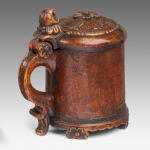Late 17th Century Norwegian Peg Tankard in Karelian Birch
NORWAY, CIRCA 1680
23 x 20.5 x 15.75 cm
9 x 8 x 6 ¼ in
9 x 8 x 6 ¼ in
7118
Further images
Provenance
Acquired in the London antiques trade in the 1960s
Private Collection, UK
The domed lid carved with a large central flower head issuing three scrolls of foliage and flowers on a punched ground within a carved line and dot border, the hinge...
The domed lid carved with a large central flower head issuing three scrolls of foliage and flowers on a punched ground within a carved line and dot border, the hinge topped with a scrolled foliate thumbpiece above a flower, opening to reveal an interior with an ale line, the handle carved with trailing foliate decoration and terminating in a supporting foot, the cylindrical body with four feet in the form of compressed flower heads, on a scalloped base.
Edward H. Pinto comments that ‘[w]ooden tankards were the commonest drinking vessels of North-west Europe over many centuries.’ He describes the way in which they were manufactured: ‘They were made in three parts-the turned tankard or cup, the handle pegged on, which includes half the wood hinge, and the lid, which incorporates the ornamental thumb lift and the other half of the hinge.’ (‘Treen and Other Wooden Bygones’ (Bell & Hyman Ltd., London, 1979), p.57-58).
Drinking customs were significant social rituals in Norway and other parts of Scandinavia. Wooden interpretations of the popular silver shapes from the later 17th century were made to suit less wealthy communities. The form of this tankard with its straight sides and the distinctive, purely floral decoration mark it out as an early example.
Edward H. Pinto comments that ‘[w]ooden tankards were the commonest drinking vessels of North-west Europe over many centuries.’ He describes the way in which they were manufactured: ‘They were made in three parts-the turned tankard or cup, the handle pegged on, which includes half the wood hinge, and the lid, which incorporates the ornamental thumb lift and the other half of the hinge.’ (‘Treen and Other Wooden Bygones’ (Bell & Hyman Ltd., London, 1979), p.57-58).
Drinking customs were significant social rituals in Norway and other parts of Scandinavia. Wooden interpretations of the popular silver shapes from the later 17th century were made to suit less wealthy communities. The form of this tankard with its straight sides and the distinctive, purely floral decoration mark it out as an early example.










